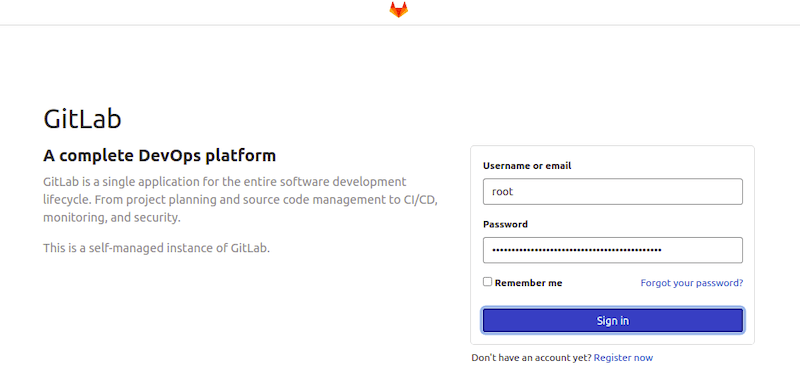How To Install GitLab on CentOS Stream 10

In this tutorial, we will show you how to install GitLab on CentOS Stream 10. GitLab is a powerful platform that combines Git repository management, continuous integration, and project management in one package. It has gained immense popularity among developers and teams due to its robust features and flexibility. This article will guide you through the process of installing GitLab on CentOS Stream 10, ensuring you have a self-hosted solution for your development needs.
Understanding GitLab
GitLab is an open-source tool that provides a comprehensive suite for software development. It allows teams to collaborate on code, manage projects, and automate the deployment process. GitLab comes in two main editions: the Community Edition (CE) and the Enterprise Edition (EE). The CE is free and open-source, while the EE includes additional features tailored for larger organizations.
Self-hosting GitLab offers several benefits, including:
- Control: You have complete control over your data and configurations.
- Customization: Tailor the platform to fit your specific needs.
- Cost-Effective: Avoid subscription fees associated with cloud-based solutions.
Prerequisites for Installation
Before diving into the installation process, ensure that your system meets the following prerequisites:
System Requirements
- CPU: Minimum of 2 cores recommended.
- RAM: At least 4 GB; 8 GB or more is ideal for larger teams.
- Disk Space: A minimum of 10 GB free space is required; more may be necessary based on usage.
Software Requirements
- Operating System: CentOS Stream 10 must be installed on your server.
- User Privileges: You will need root or sudo privileges to install packages and configure settings.
A basic understanding of Linux commands will also be beneficial as you navigate through the installation process.
Step-by-Step Installation Guide
Step 1: Update the System
The first step in installing GitLab is to ensure that your system is up-to-date. This helps avoid compatibility issues with packages. Open your terminal and run the following command:
sudo dnf update -yThis command updates all installed packages to their latest versions. After the update completes, it’s a good practice to reboot your system using:
sudo rebootStep 2: Install Required Dependencies
Next, you need to install several dependencies that GitLab requires to function properly. Execute the following command in your terminal:
sudo dnf install -y curl policycoreutils openssh-server postfixThe packages included in this command are essential for managing security policies, handling email notifications, and enabling SSH access.
Step 3: Configure Postfix
Postfix is a mail transfer agent that will handle email notifications from GitLab. To configure Postfix, you can use the following command to start its configuration wizard:
sudopostconf -e "myhostname = gitlab.example.com"This command sets the hostname for Postfix. Follow the prompts to complete the configuration. You can choose “Internet Site” when asked about the type of mail server. After finishing, restart Postfix with:
sudo systemctl restart postfixStep 4: Add the GitLab Repository
The next step is to add the official GitLab repository to your system. This ensures that you are installing the latest version of GitLab CE. Run this command in your terminal:
curl -sS https://packages.gitlab.com/install/repositories/gitlab/gitlab-ce/script.rpm.sh | sudo bashThis script automatically adds the repository and updates your package manager’s cache.
Step 5: Install GitLab
You are now ready to install GitLab itself. Use the following command to install it while specifying your external URL:
sudo EXTERNAL_URL="http://yourdomain.com" dnf install -y gitlab-ceThis command installs GitLab CE on your server. Replace http://yourdomain.com with your actual domain name or IP address where GitLab will be accessible.
Step 6: Configure GitLab
Once the installation finishes, you need to configure GitLab by running this command:
sudo gitlab-ctl reconfigureThis command initializes and configures all necessary components based on your settings in /etc/gitlab/gitlab.rb. You can edit this file if you want to customize any settings before running reconfigure.
Step 7: Adjust Firewall Settings
If you have a firewall enabled on your CentOS system, you’ll need to allow HTTP, HTTPS, and SSH traffic. Use these commands to open the necessary ports:
sudo firewall-cmd --permanent --add-service=http
sudo firewall-cmd --permanent --add-service=https
sudo firewall-cmd --permanent --add-service=ssh
sudo firewall-cmd --reload
This configuration ensures that users can access GitLab via web browsers and SSH clients securely.
Step 8: Accessing GitLab
Your GitLab instance should now be up and running! Open a web browser and navigate to http://yourdomain.com. You will be greeted with a login screen where you can set up an admin password for the root user.

Post-Installation Considerations
A successful installation of GitLab is just the beginning. Here are some post-installation considerations to enhance security and performance:
- SSL Configuration: It’s crucial to secure your instance with SSL certificates. Tools like Let’s Encrypt can provide free SSL certificates easily.
- User Management: Create user accounts for team members and assign appropriate roles based on their responsibilities.
- Scheduling Backups: Regularly back up your GitLab instance using built-in backup tools to prevent data loss.
- Sustaining Updates: Keep your installation updated by regularly checking for new releases from GitLab.
- Tuning Performance: Monitor resource usage and optimize configurations as necessary based on team size and project load.
Troubleshooting Common Issues
If you encounter issues during or after installation, consider these common problems and their solutions:
- Error during installation: If you see dependency errors, ensure all required packages are installed correctly. Running
sudodnf clean all, followed by another attempt at installation may help. - Email notifications not working: If Postfix isn’t sending emails, check its logs located at
/var/log/maillog. Ensure it’s properly configured as described above. - Cannot access web interface: If you can’t reach your GitLab instance via a web browser, verify that you’ve opened ports in your firewall correctly and check if GitLab services are running using
sudogitlab-ctl status. - Password reset issues: If you’re unable to log in due to forgotten passwords, use the command
sudogitlab-rake "gitlab:password:reset", following prompts to reset it directly from the terminal. - Poor performance or slow response times: If performance degrades over time, consider analyzing logs in
/var/log/gitlab/, optimizing database settings, or increasing server resources as needed.
Congratulations! You have successfully installed GitLab. Thanks for using this tutorial for installing GitLab on your CentOS Stream 10 system. For additional or useful information, we recommend you check the official GitLab website.